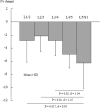Acute Physiological Response of Lumbar Intervertebral Discs to High-load Deadlift Exercise
- PMID: 32879259
- PMCID: PMC8424024
- DOI: 10.2463/mrms.mp.2020-0052
Acute Physiological Response of Lumbar Intervertebral Discs to High-load Deadlift Exercise
Abstract
Purpose: We aimed to evaluate the acute physiological effects of high-load deadlift exercise on the lumbar intervertebral discs using MR diffusion-weighted imaging (DWI).
Methods: Fifteen volunteers (11 men and 4 women; 23.2 ± 3.3 years) without lumbar intervertebral disc degeneration performed deadlift exercise (70% of 1 repetition maximum, 6 repetitions, 5 sets, 90 s rest between sets) using a Smith machine. Sagittal MR diffusion-weighted images of the lumbar intervertebral discs were obtained using a 1.5-Tesla MR system with a spine coil before and immediately after the exercise. We calculated apparent diffusion coefficient (ADC; an index of water movement) of the nucleus pulposus from diffusion weighted images at all lumbar intervertebral discs (L1/2 through L5/S1).
Results: All lumbar intervertebral discs showed significantly decreased ADC values immediately after deadlift exercise (L1/2, -2.8%; L2/3, -2.1%; L3/4, -2.8%; L4/5, -4.9%; L5/S1, -6.2%; P < 0.01). In addition, the rate of ADC decrease of the L5/S1 disc was significantly greater than those of the L1/2 (P = 0.017), L2/3 (P < 0.01), and L3/4 (P = 0.02) discs.
Conclusion: The movement of water molecules within the lumbar intervertebral discs is suppressed by high-load deadlift exercise, which would be attributed to mechanical stress on the lumbar intervertebral discs during deadlift exercise. In particular, the L5/S1 disc is subjected to greater mechanical stress than the other lumbar intervertebral discs.
Keywords: intradiscal water movement; lifting; lumbar spine; magnetic resonance diffusion-weighted image; mechanical stress.
Conflict of interest statement
We have no conflicts of interest to declare.
Figures



Similar articles
-
Acute effects of varying squat depths on lumbar intervertebral disks during high-load barbell back squat exercise.Scand J Med Sci Sports. 2021 Feb;31(2):350-357. doi: 10.1111/sms.13850. Epub 2020 Oct 22. Scand J Med Sci Sports. 2021. PMID: 33038028
-
Diffusion-weighted 7.0T Magnetic Resonance Imaging in Assessment of Intervertebral Disc Degeneration in Rats.Chin Med J (Engl). 2018 Jan 5;131(1):63-68. doi: 10.4103/0366-6999.221261. Chin Med J (Engl). 2018. PMID: 29271382 Free PMC article.
-
Diffusion-weighted magnetic resonance imaging of normal and degenerative lumbar intervertebral discs: a new method to potentially quantify the physiologic effect of physical therapy intervention.J Orthop Sports Phys Ther. 2008 Feb;38(2):42-9. doi: 10.2519/jospt.2008.2631. Epub 2007 Sep 21. J Orthop Sports Phys Ther. 2008. PMID: 18560192
-
Measurement of Three-Dimensional Internal Dynamic Strains in the Intervertebral Disc of the Lumbar Spine With Mechanical Loading and Golden-Angle Radial Sparse Parallel-Magnetic Resonance Imaging.J Magn Reson Imaging. 2021 Aug;54(2):486-496. doi: 10.1002/jmri.27591. Epub 2021 Mar 13. J Magn Reson Imaging. 2021. PMID: 33713520 Free PMC article. Review.
-
Structured image diagnosis of vertebral body degeneration and disc damage - Binary image criteria and comparison for systematic image analysis in occupational diseases 2108/2110.Rofo. 2024 Apr;196(4):347-353. doi: 10.1055/a-2168-7399. Epub 2023 Dec 21. Rofo. 2024. PMID: 38128569 Review. English, German.
Cited by
-
How Physical Activity Affects Knee Cartilage and a Standard Intervention Procedure for an Exercise Program: A Systematic Review.Healthcare (Basel). 2022 Sep 21;10(10):1821. doi: 10.3390/healthcare10101821. Healthcare (Basel). 2022. PMID: 36292268 Free PMC article. Review.
-
Applications of Diffusion-Weighted MRI to the Musculoskeletal System.J Magn Reson Imaging. 2024 Feb;59(2):376-396. doi: 10.1002/jmri.28870. Epub 2023 Jul 21. J Magn Reson Imaging. 2024. PMID: 37477576 Free PMC article. Review.
References
-
- Cholewicki J, McGill SM, Norman RW. Lumbar spine loads during the lifting of extremely heavy weights. Med Sci Sports Exerc 1991; 23:1179–1186. - PubMed
-
- Swinton PA, Stewart A, Agouris I, Keogh JW, Lloyd R. A biomechanical analysis of straight and hexagonal barbell deadlifts using submaximal loads. J Strength Cond Res 2011; 25:2000–2009. - PubMed
-
- Siewe J, Rudat J, Röllinghoff M, Schlegel UJ, Eysel P, Michael JW. Injuries and overuse syndromes in powerlifting. Int J Sports Med 2011; 32:703–711. - PubMed

